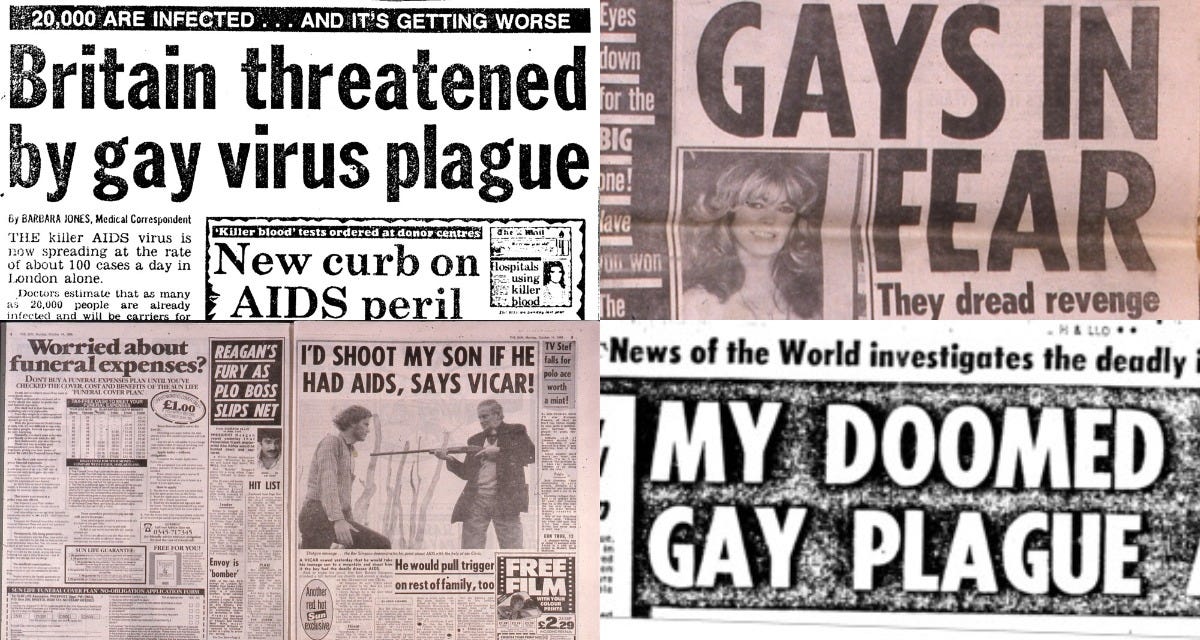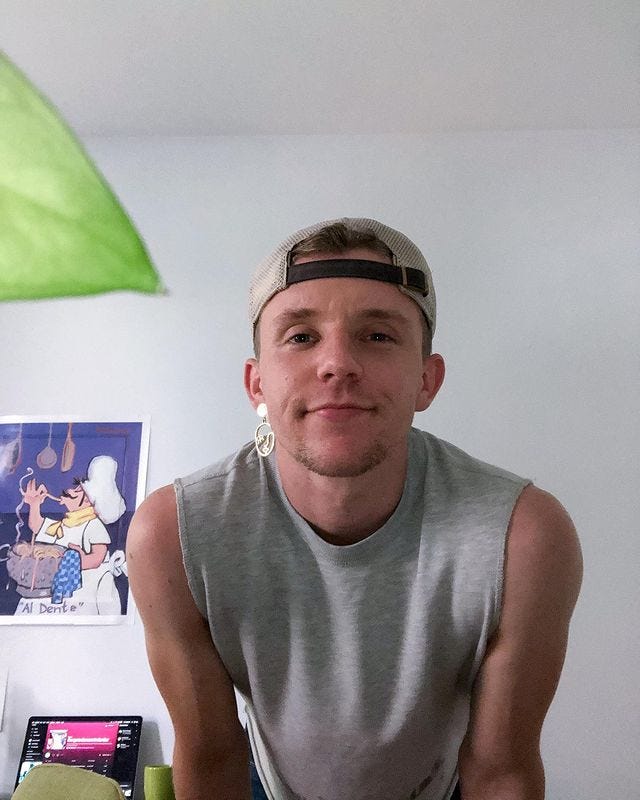As always, subscribe for free & share this newsletter if it spoke to you :)

Happy Friday, everyone :)
Hope you’re all doing ~ swell ~ (love that word, makes me feel like I’m a 1920s flapper out on the town, ya know?)
Today we’re going to talk about blood. More specifically, gay blood.
Did you know we’re coming out of a national blood shortage here in the U.S.? The pandemic took a “severe” toll on the nation’s blood supply, according to the Red Cross, mostly due to an “unprecedented” number of blood drive cancellations due to the virus.
So, considering we’re getting that pesky virus under control these days (at least in the U.S.) we should all be donating blood right now, right?
Well, as it turns out, not everyone thinks we all bleed the same color ( *ahem* @ the FDA )
I was semi-mindlessly scrolling through Instagram yesterday, as one does, when I came across this story a friend had posted.

It urges everyone to go sign a petition that would lift a blood-donation ban that exists on gay men.
If you’re a man who has sex with men (often abbreviated as “MSM” by the FDA), you’ve got to stay away from the dick for at least 3 months before you can give blood.
Yup, you heard that right. In accordance with the most up-to-date FDA regulations (see “III. Reccomendations, A., I./J.) if you’re a man who’s had sexual contact with another man in the past 3 months (or a women who’s had sexual contact with a man who’s had sexual contact with another man in the past 3 months – I know, my head is spinning too), you cannot give blood.
*This ban also applies to anyone assigned male at birth that has sex with others assigned male at birth.
Ok, let me take a breath here.
First of all, you should all sign the petition below (it takes two seconds and I believe it’s reliable – GLAAD is a reputable LGBTQ+ organization that does some great work).

Second of all, what the actual fuck.

We’re in a national blood shortage, and we’re making it harder for a potentially huge population of healthy donors to give their blood?
How the hell did we get here?
Well, to answer that question, we first have to understand where this blood ban came from – which, as you might have already been able to piece together, ties directly into deeply rooted, blatantly homophobic HIV/AIDS-related stigma.
Before I get into that, you should know about Avert – an international HIV and AIDS charity. It’s an amazing resource to educate yourself on all things HIV/AIDS. Check it out.
Ok, now let’s dig into this stigma.
The AIDS epidemic has left scars.
*I found an entire, in-depth, interactive timeline of the HIV/AIDS epidemic on HIV.gov – check that out here – that you might find interesting. Here I’ll just be covering the basics.
Stretching from the 1970s to today and raging on in parts of the world, the AIDS epidemic has seen 76 million people infected with HIV and tens of millions dead from AIDS-related illness. Still today, approximately 38 million people are living with HIV globally.
Fortunately, due to the combined efforts of scientists in the lab and revolutionaries out in the streets, HIV is no longer a death sentence.
With access to modern treatments, HIV-positive individuals can expect to live as long as their HIV-negative peers. There are even widely-distributed HIV-preventative drugs on the market today, like PrEP, that are reported to reduce your risk of infection by 99% (more info on PrEP from the CDC here).
Unfortunately, none of this happened before an entire generation of gay men and queer folk in the U.S. were virtually wiped off the map.
There is literally a chunk of gay men and queer folk assigned male at birth missing from the generational lineage because of this virus.
Unfortunately (again) the virus’s massive impact on the queer community made it all to easy for homophobes the world over to cement the idea that gay is synonymous with HIV/AIDS.

This is not reality. HIV/AIDS is not, as some once believed, a “gay plague”.
It makes sense that people once thought that. I mean, a huge number of gay men were dying of AIDS-related causes and lord knows the public had homophobic messaging bombarding them from all angles.
The reality, though, is that anyone can be HIV positive – gay, straight, cis or trans.
HIV is primarily transmitted via blood and specific bodily fluids – AKA semen, vaginal fluids, anal fluids, or breast milk. We all have those fluids, so we can all transmit the virus.*
*You CANNOT get HIV/AIDS from someone who is positive from casual contact, which Planned Parenthood defines as “kissing, hugging, or sharing drinking glasses or utensils.” This is a HUGE misconception that I want to help combat.
Although HIV/AIDS can be transmitted in a few different ways, unprotected sex and anal sex have historically been centered in the narrative (and not without reason).
The main reason gay men are impacted so disproportionately by the virus is because of, you guessed it, unprotected anal sex.
That’s it. It’s not because they’re queer and having anal sex, it’s because they’re having anal sex and doing it without a condom. Being queer holds no place in the actual narrative.
Here’s how I put it in my third-ever newsletter (and might I add, one of my favorites, still to this day), “Let’s Talk About Sex, Baby!”
Period!

Questions about your sexuality do not belong on the donor history questionnaire. Questions about your safe sex practices do.
The solution to this issue, I think, is pretty simple. Considering what constitutes someone’s potential exposure to HIV has everything to do with their sexual risk behavior and nothing to do with the gender of their partner, shouldn’t the questionnaire you have to fill out focus on that instead?
I found this amazing Op-Ed written by an LGBTQ+ writer on GLAAD that I think brings this point home perfectly, so I’ll paste his words here.
“In reality, risk factors for HIV transmission including behaviors such as having unprotected sex and having multiple sex partners are identical regardless of someone’s sexual orientation … Under current guidelines, a monogamous gay man on PrEP who has had protected sex in the past three months with a long-term male partner would not be able to donate blood while a heterosexual male who has had unprotected sex with multiple female partners in the same time period would be allowed to donate. Situations like this exhibit how blood donation deferral policies based on sexual orientation are rooted in prejudices as opposed to scientific evidence.”
– Jeremy Wang, “how anti-lgbtq fear, not science, is keeping the blood ban in place”
#EndTheBloodBan and, for the love of all that is holy, stop equating queer folks with HIV/AIDS. This pride month, focus instead on honoring those we’ve lost – we can start by granting the next generation the right to donate blood freely.
A lil’ P.S.
I *officially* came out as gender fluid on my Instagram yesterday (@till_kaeslin).
I guess it wasn’t really a coming out (I hate that phrase and the idea of it all), but more just a post for visibility – an effort to fill a space that sat empty when I was a kid; an effort to be someone my younger self could’ve seen themselves in (which would’ve made everything a whole lot easier).
I’ll be posting more about gender fluidity here at some point I’m sure, along with some resources to learn more about gender expansiveness in general. In the meantime, feel free to send me any and all questions you might have – I’m open (but to be clear, I only speak for myself when I offer that up).
For now, just know gender fluid is the label that fits me most and that I feel pretty damn great about it :)
Pronouns are he/him/his & they/them/theirs – either or works for me :) As *literally* always, thanks for all your support ❤️ Truly love this community *sappy but true, nonetheless*
Till next time, folks 👋
Find me on Instagram: @till_kaeslin
Check out the newsletter’s home on Instagram: @thatsgaynewsletter
And that was That’s Gay, Volume 49.
See you in Volume 50, folks! OMG, the 50th anniversary :)
Don’t want to miss Volume 50? Not signed up yet?
Share this newsletter and help my baby grow!





